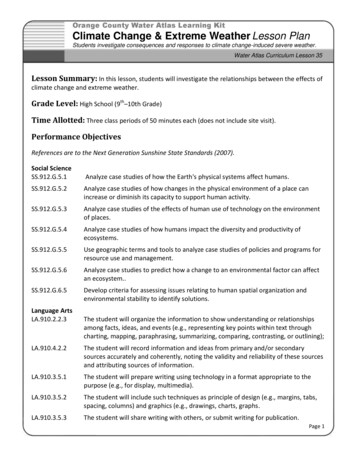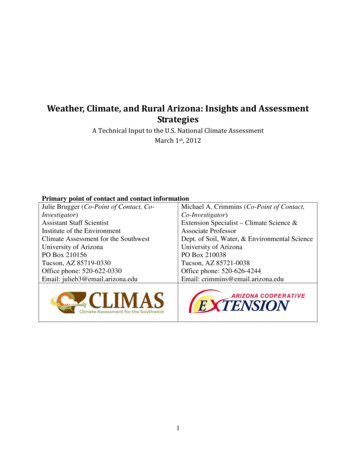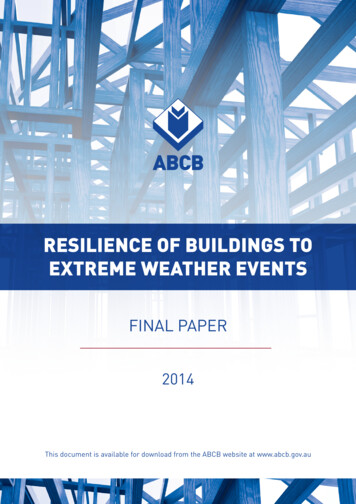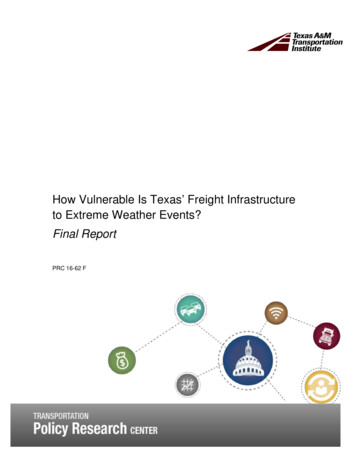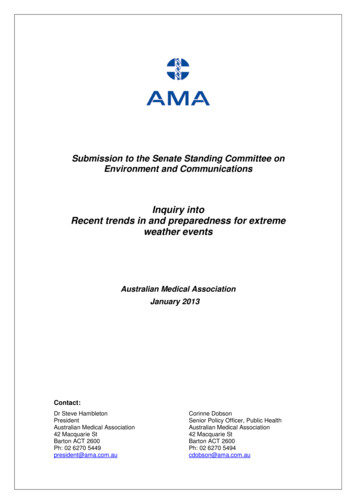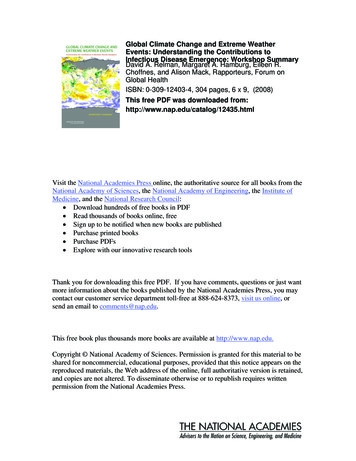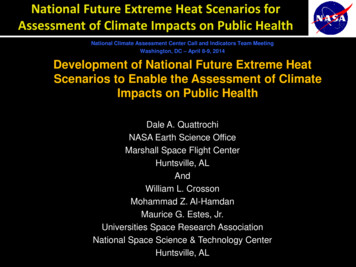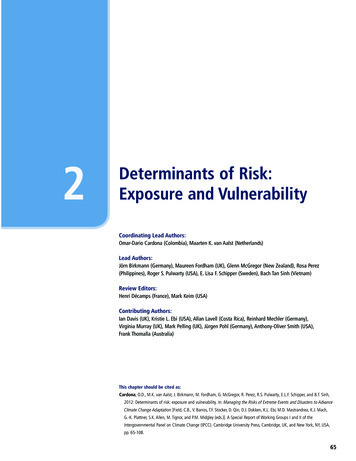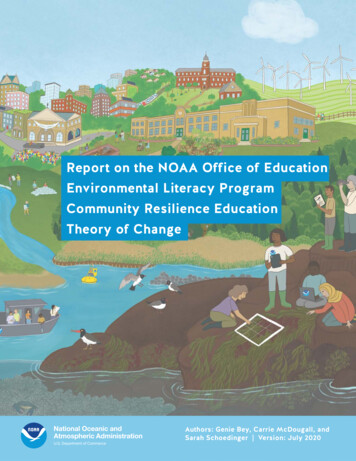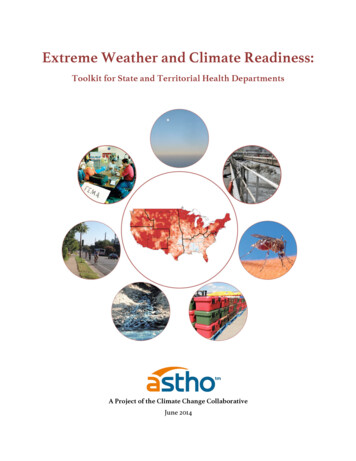
Transcription
Extreme Weather and Climate Readiness:Toolkit for State and Territorial Health DepartmentsA Project of the Climate Change CollaborativeJune 2014
Purpose of this ToolkitRecognizing that the changing climate is a significant threat to the health of ourcommunities, the Association of State and Territorial Health Officials (ASTHO) hascreated this toolkit to help state and territorial health agencies enhance their climatereadiness, program by program. The toolkit offers practical steps for integrating climatereadiness into seven public health topic areas: air quality, water safety, vector-borneand zoonotic disease, food safety, chemical safety, healthy sustainable communitiesand injury prevention, and natural disaster emergency preparedness. Worksheets havebeen provided throughout the toolkit to assist readers in performing Climate ReadinessAssessments in each topic area.Copyright 2014. All Rights ReservedThe development of this resource was supported by Cooperative Agreement5U38HM000454 from the Centers for Disease Control and Prevention. Its contents aresolely the responsibility of the authors and do not necessarily represent the official viewsof the Centers for Disease Control and Prevention.This report is available online at: http://www.astho.orgSuggested format for citing this publication:Association of State and Territorial Health Officials Climate Change Collaborative.Extreme Weather and Climate Readiness: Toolkit for State Health Departments.Arlington, VA; 2013:126. Available at: http://www.astho.org.i
AcknowledgementsLEAD AUTHORAdele Houghton, Biositu, LLCREVIEWERSHenry “Andy” Anderson, Wisconsin Division of Public HealthNorman Anderson, Maine Center for Disease Control and PreventionBryon Backenson, New York State Department of HealthKathy Clancy, New York Department of HealthKathy Dervin, California Department of Public HealthJulia Gold, Rhode Island Department of HealthJennifer Goodnight, ASTHOLarry Hill, Virginia Department of HealthH. Bruce "Jeff" Jeffries, Georgia Department of Public HealthAnne Kjemtrup, California Department of Public HealthAbraham Kulungara, ASTHOMeenoo Mishra, ASTHOJeffrey Phillips, Wisconsin Department of Health ServicesMargaret M. Round, Massachusetts Department of Public HealthMina Shehee, North Carolina Department of Health and Human ServicesSurili Sutaria, Association of Public Health LaboratoriesJim Vannoy, Idaho Department of Health and WelfareCharles Warzecha, Wisconsin Department of Health ServicesMichael Wichman, The University of IowaSPECIAL THANKS TO THE STATES WHO PILOTED THE DRAFT inii
Table of ContentsAcknowledgements . iiIntroduction . 1Health Equity & Climate Change 3Climate Readiness Frameworks . 4How to Use this Toolkit . 6Integrating Climate Readiness by Topic Area . 71. Air Quality 92. Water Safety 203. Vector-borne & Zoonotic Disease . 324. Food Safety . 445. Chemical Safety . 556. Healthy Sustainable Communities &Injury Prevention . 667. Natural Disaster Emergency Preparedness . 78Climate Readiness Assessment Resources . 92References . 96iii
Introduction“Weather and climate have always had a key influence onhuman health. This influence on our lives willincrease with climate change.”Chris Portier, Ph.D.Former Director of the CDC National Center for Environmental Health and1Agency for Toxic Substances and Disease RegistryEvery state and territorial public health program, from Air Qualityto Zoonotic Disease, has started to feel the effects of thechanging climate. The direct effects include increased frequencyand / or severity of extreme weather events such as: heat waves,heavy precipitation, hurricanes, flooding, snowstorms, drought,FIGURE 1: OBSERVED U.S. TEMPERATURE CHANGE, 1991-2012Image Source: Melillo, Jerry M., Terese (T.C.) Richmond, and Gary W. Yohe, Eds., 2014: Climate Change Impacts in theUnited States: The Third National Climate Assessment. U.S. Global Change Research Program. Figure source: NOAANCDC / CICS-NC.ASTHOExtreme Weather and Climate Readiness: Toolkit for State and Territorial Health Departments1
and wildfires. Indirect effects include increased risk of vector-borne and zoonoticdiseases, population displacement, and threats to food security.ASTHO has taken several steps to support actions preparing the state and territorialpublic health infrastructure to address climate-related challenges.ASTHO§ In 2007, ASTHO supported Commissioner Susan Cooper (TN) during herpresentation on Climate Change to the U.S Senate Committee on Environmentand Public Works. (Resource: Commissioner Cooper’s statement.)§ In 2008, ASTHO formed the Climate Change Collaborative: a multidisciplinary team of experts who provide guidance regarding the mosteffective ways for ASTHO to support and build climate and health capacitywithin state and territorial health agencies. (Resource: Notes from themost recent Climate Change Collaborate in-person meetings.)§ In 2008, ASTHO hosted a webinar series examining several aspects ofpublic health impacts of climate change, including heat stress, water, andvectors. (Resource: Webinar presentations.)§ In 2009 and 2012, ASTHO administered climate change needsassessment surveys designed to capture climate change perspectives andcapacities within state and territorial health agencies.(Resource: Summary reports of both assessments.)§ In 2011, ASTHO released the Climate Change Threatens Public HealthPosition Statement outlining the health effects of climate change andpotential public health responses, including: understanding andpreparedness, education and outreach, and assessment and policy.(Resource: Position statement.)§ ASTHO, in conjunction with the Centers for Disease Control andPrevention (CDC) / National Center for Environmental Health (NCEH), hasfunded three rounds of capacity building grants. To date, this program hasfunded 12 projects in a total of 8 states. (Resource: Grantee webpage.)§ ASTHO has also co-sponsored two rounds of climate and health webinarseries in conjunction with CDC, American Public Health Association(APHA), Society for Public Health Education (SOPHE), and NationalAssociation of County and City Health Officials (NACCHO). The webinarshighlighted best practices at the state and local levels and guidance onhow public health tools can be used to enhance the capacity of state andlocal health departments in addressing climate change.(Resource: Webinar archives.)§ In 2013, ASTHO hosted a two-part webinar series about using CDC'sBuilding Resilience Against Climate Effects (BRACE) Framework to preparefor the health effects of climate change. This framework supports healthdepartments in incorporating advanced climate models into healthdepartment planning and response activities. (Resource: Webinar archives.)Extreme Weather and Climate Readiness: Toolkit for State and Territorial Health Departments2
This toolkit, a product of the Climate Change Collaborative, applies the framework laidout by the ASTHO climate change position statement to address the capacity gapsidentified in the ASTHO climate change needs assessment surveys.Recognizing that the organization of health agencies changes from one state / territoryto the next, the toolkit outlines a comprehensive approach to integrating climatereadiness into all policies and programs. It is divided into seven thematic content areas,all of which are likely to address elements of multiple departments, and, possibly,programs in multiple agencies. Key program areas — such as chronic disease andhealth equity — that are relevant to most or all public health activities are crossreferenced throughout the toolkit. This organization reflects the need for public healthagencies to bring an interdisciplinary approach to addressing the health effects ofextreme weather and climate change. Such an approach can protect lives, reduce costs,improve effectiveness, and build valuable relationships both internally and with externalpartners.Health Equity and Climate ChangeASTHO has identified “promoting health equity” as a crosscutting goal of theorganization, in alignment with the World Health Organization’s (WHO) position that “theobjective of good health is twofold: the best attainable average level — goodness —and the smallest feasible differences among individuals and groups — fairness.”2 Healthinequities exist among groups based on gender, sexual orientation, race, ethnicity,education, income, disability, and geographic location. In addition, the burden of healthinequities constitutes a huge financial and social cost to our nation in terms of thequality and quantity of life.The social determinants of health are the conditions in which people are born, grow, live,work, and age. These circumstances are in turn shaped by a wider set of forces:economics, social policies, and politics.3 Health and the ability to adapt to climatechange are largely determined by these factors.4 Older adults, children, and low-incomecommunities are disproportionately vulnerable to the health effects of climate change,such as heat stress, increased costs of energy and food, and increased cardiovascularand respiratory disease.5Environmental justice issues are critical to understand in relation to climate change andhealth inequities. According to the U.S. Environmental Protection Agency (U.S. EPA),“environmental justice is the fair treatment and meaningful involvement of all peopleregardless of race, color, national origin, or income with respect to the development,implementation, and enforcement of environmental laws, regulations, and policies.”6Climate change policy should take health inequities and environmental injustices intoaccount and incorporate social determinants into the planning and implementation ofclimate change programs and policy to contribute to the elimination of health disparitiesand achievement of health equity.7ASTHOExtreme Weather and Climate Readiness: Toolkit for State and Territorial Health Departments3
Climate Readiness FrameworksClimate change represents a significant threat to population health, health equity, andpublic health infrastructure.8 However, according to both the 2009 and 2012 ASTHOclimate and health needs assessments, the state of climate readiness varies bothacross state and territorial health agencies and across departments within agencies.9Climate preparedness programs must therefore be tailored to the needs andorganizational realities of each state / territorial health agency.The guidance in this toolkit aligns with two frameworks for assessing a state or territorialhealth agency’s climate readiness: the more basic three core functions of public health10and, at a more advanced level, the Building Resilience Against Climate Effects(BRACE) Framework.11The three core functions of public health — assessment, policy development, andassurance — were identified by the 1988 Institute of Medicine Report, The Future ofPublic Health, as the three primary areas of responsibility for public health agencies inthe U.S.10 In 1994, additional detail was published in the form of the 10 Essential PublicHealth Services,12 which today provide the framework for Tribal, state, territorial, andlocal public health accreditation programs.13 For agencies with little or no experience inclimate change, organizing a climate and health program according to the three corefunctions of public health (and the associated 10 Essential Public Health Services) willoffer a bird’s eye view of how this approach can bolster existing programs andorganizational objectives.FOR MORE INFORMATION ABOUT THE THREE CORE FUNCTIONS OF PUBLIC HEALTH AND THE 10ESSENTIAL PUBLIC HEALTH SERVICES, VISIT:http://www.cdc.gov/nceh/ehs/ephli/core .htmlFor agencies interested in integrating climate readiness into ongoing accreditationactivities, the New Hampshire Department of Health and Human Services developed aclimate ready gap analysis / needs assessment instrument that is based on CDC’sNational Public Health Performance Standards Program (NPHPSP)14 and organized bypublic health core function areas and the 10 Essential Public Health Services. Theassessment tool can be used by state and territorial public health agencies to quicklydetermine climate ready capabilities that are already in place and areas requiringimprovement. Download the tool here (see page 19).Agencies with existing climate and health programs and states / territories with climateaction plans may find the five-step BRACE framework a more appropriate assessmenttool, because it offers a more in-depth approach to enhancing climate readiness.ASTHOExtreme Weather and Climate Readiness: Toolkit for State and Territorial Health Departments4
THE BRACE FRAMEWORK WALKS USERS THROUGH THE PROCESS OF:§ anticipating the likely climatic changes in their region;§ identifying the particular risks to vulnerable populations;§ predicting the most significant health effects associated with different exposures; and,§ developing relevant tracking programs, policy and programmatic interventions, andprogram evaluation methodologies.11The BRACE process emphasizes the importance of engaging key partners aroundpublic health goals, including other state / territorial agencies that may follow differentplanning models11 — such as state hazard mitigation plans developed for the FederalEmergency Management Agency (FEMA), sea level rise studies undertaken for theNational Oceanic and Atmospheric Administration (NOAA) and the United StatesGeological Survey (USGS), and wildfire planning undertaken in response to directivesfrom the United States Department of Agriculture (USDA) and the United States FireAdministration (USFS).BRACE limits inefficiencies by helping public health agencies identify and supportclimate impact models (such as vulnerability assessments) and adaptation interventions(such as policies that reduce the urban heat island effect) that enhance co-benefits topopulation health.11 For example, the California Energy Commission took the lead incommissioning local universities to develop downscaled climate models. The statehealth department is able to make use of the resulting open-source website, www.caladapt.org, rather than developing a separate downscaled climate model. To date,CDC’s Climate and Health Program has funded the adoption of the BRACE frameworkin 16 states and two local health departments through the Climate Ready States andCities Initiative.15FOR MORE INFORMATION ABOUT THE BRACE FRAMEWORK AND LINKS TO CASE STUDIES, VISIT:http://www.cdc.gov/climateandhealth/climate ready.htmASTHOExtreme Weather and Climate Readiness: Toolkit for State and Territorial Health Departments5
How to Use this ToolkitThis toolkit has been designed to serve dual purposes.1. BUILDING AWARENESS & CAPACITY:The toolkit provides background information on how to build climate readiness into stateand territorial health agencies. This information can be used to build awareness withinyour agency about how the changing climate is impacting both community health andthe public health infrastructure designed to protect it. The toolkit may be distributed in itsentirety or section-by-section to relevant departments and programs.2. ASSESSING CLIMATE READINESS:For states and territories that are interested in integrating extreme weather and climatechange into their planning process or have already launched a climate readinessinitiative, the toolkit provides activities that are designed to align with the agency’sexisting assessment framework, whether organized around the three core functions ofpublic health and the Ten Essential Public Health Services12 or the BRACEFramework,11 which is being implemented by the recipients of CDC’s Climate ReadyStates and Cities Initiative grant program.Climate readiness is a collaborative endeavor. The effects of extreme weather andclimate change cut across geographic scale, political jurisdiction, and agency scope.While health agencies bring an important perspective to climate readiness policies andinitiatives, they often do not lead the process. The activities accompanying this toolkitwill therefore likely require input from other departments. States / territories likeMassachusetts16 that have convened a multi-agency adaptation workgroup may chooseto complete the activities as part of that body’s work. In other states / territories, theactivities can be used to start a conversation with partner agencies about opportunitiesfor future collaboration on climate readiness efforts.ASTHOExtreme Weather and Climate Readiness: Toolkit for State and Territorial Health Departments6
Climate Readiness by Topic AreaThe impacts of extreme weather events and climate change touchall public health departments and programs. For this reason, asuccessful climate and health initiative must be integrated into alllevels of the agency, from the programmatic and departmentlevels on up. It requires a fundamental shift in approach,supplementing historical data with climate projections to assessthe relative risk of changing patterns of environmental hazards,vulnerabilities, and health outcomes. It will also require aninvestment in staff training and capacity development throughoutthe public health agency (Figure A).FIGURE A. INCREASING CLIMATE & HEALTH CAPACITY ATSTATE & TERRITORIAL HEALTH AGENCIESClimate and health training materials tailored to the needs of public healthpractitioners are becoming increasingly available. The websites included in the listbelow combine national resources with local and regional case studies. However,a search of the web may also find trainings that are specific to a particular region.While by no means comprehensive, the list below is a good place to start learningabout the links between climate change and health:ASTHO§ Association of State and Territorial Health Officials (ASTHO)§ American Public Health Association (APHA)§ Council of State And Territorial Epidemiologists (CSTE)§ National Association of County and City Health Officials (NACCHO)§ U.S. Centers for Disease Control and Prevention (CDC)Extreme Weather and Climate Readiness: Toolkit for State and Territorial Health Departments7
THE FOLLOWING SECTIONS OFFER TOOLS AND INSIGHT INTO ENHANCING CLIMATE READINESSIN SEVEN TOPIC AREAS, ALL OF WHICH COMBINE CORE PUBLIC HEALTH SERVICES WITH KEYPARTNERS BOTH WITHIN AND EXTERNAL TO THE STATE OR TERRITORIAL HEALTH AGENCY:1. Air Quality5. Chemical Safety2. Water Safety6. Healthy Sustainable Communities& Injury Prevention3. Vector-borne & Zoonotic Disease4. Food Safety7. Natural Disaster EmergencyPreparednessEACH SECTION IS DIVIDED INTO FOUR PARTS:1. an overview of the effects of extreme weather and climate change on the publichealth infrastructure;2. opportunities for integrating climate readiness into existing programs;3. tracking climate readiness; and,4. a review of the evidence that a climate readiness approach can offer co-benefits tohealth, financial wellbeing, and the environment.ASTHOExtreme Weather and Climate Readiness: Toolkit for State and Territorial Health Departments8
1. Air QualityEffects of Extreme Weather and Climate ChangePoor air quality accounts for hundreds of thousands of prematuredeaths each year globally.17 In 2005, a single air pollutant — fineparticulate matter (PM2.5) — was estimated to result in 130,000premature deaths and 4,700 ozone-related deaths in the U.S.18Long-term exposure to poor outdoor air quality can lead toimpaired lung development among children;19 and, it is associatedwith respiratory and cardiovascular diseases.17,20 Wildfire smokecan exacerbate these effects in areas with high levels ofbackground air pollution — particularly among vulnerablepopulations. For example, the 2003 wildfires in SouthernCalifornia were associated with increased respiratory symptomsamong children and increased respiratory-related hospitaladmissions among seniors.21,22 On the other hand, even shortFIGURE 2: EXAMPLES OF SOURCES OF POOR AIR QUALITY:OUTDOOR AIR POLLUTION. POOR INDOOR AIR QUALITY. WILDFIRES.ASTHOExtreme Weather and Climate Readiness: Toolkit for State and Territorial Health Departments9
term reductions in traffic congestion can have the opposite effect on health outcomes.For example, asthma-related visits to Atlanta emergency departments temporarily fellwhile an alternative transportation plan was enacted during the 1996 Olympic Games.23Outdoor air pollution is caused by a combination of stationary (or, point-source)emissions (such as coal-fired power plants) and mobile source emissions (such as carsand trucks).24 Wildfires also contribute to compromised air quality.25,26 Their smoke cancontain a variety of toxicants, including carbon monoxide (CO), nitrogen oxides, ozone(O3) precursors such as volatile organic compounds (VOCs), and particulate matter(PM).27 The Clean Air Act requires the U.S. Environmental Protection Agency (U.S.EPA) to regulate six “criteria” outdoor air pollutants that are found widely across thecountry and are particularly harmful to human health: CO, lead (Pb), nitrogen dioxide(NO2), O3, fine and course particulate matter (PM2.5 and PM10), and sulfur dioxide(SO2).28 It also regulates sources of hazardous air pollutants by enforcing technologybased emission standards.29 The economic burden to areas where the concentration ofcriteria air pollutants exceeds the thresholds set by the National Ambient Air QualityStandards (NAAQS) (also called “nonattainment” areas) can be substantial. Forexample, in California, where over 90% of the population is located in nonattainmentareas, poor air quality contributes to an estimated 8,800 deaths and 71 billion in healthcare costs annually.30According to the U.S. EPA, the concentration of air pollutants inside buildings can reach2-5 times the concentration of pollution in outdoor air.31 This is a particularly troublingstatistic, because people in the U.S. spend, on average, more than 90% of each dayindoors.32 Poor indoor air quality can be caused by a number of factors, including:temperature; humidity; outdoor air pollutants (introduced to the indoor environmentthrough doors, windows, and the heating and air conditioning system); buildingmaterials that emit VOCs such as formaldehyde; dust; mold; pesticides; and, cleaningchemicals.33 According the Institute of Medicine (IOM) report, Climate Change, theIndoor Environment, and Health (2011),33 many of these determinants are likely to beexacerbated by climate change (Table 1-A). For example, as outdoor air pollutionincreases, higher concentrations of contaminants will be introduced into the indoorenvironment.33 Furthermore, in an attempt to reduce the demand that mechanicalsystems place on the electrical grid, many building codes have reduced minimumrequired ventilation rates, thereby potentially increasing the concentration of pollutantsin the indoor air.33Building operations can also unintentionally exacerbate extreme weather events. Forexample, increased use of air conditioning during heat events:ASTHO§ increases the temperature of the micro-climate around the building(thereby increasing exposure to high temperatures); and,§ increases demand on the electricity source — possibly leading to abrownout or blackout and, consequently, a temporary loss of access toair conditioning.33Extreme Weather and Climate Readiness: Toolkit for State and Territorial Health Departments10
Mold growth can also compromise indoor air quality after extreme weather events thatare accompanied by flooding or extended utility disruptions. And, utility outages canlead to an additional environmental hazard: indoor exposure to carbon monoxide fromcombustion-fired generators.33The changing climate will exacerbate the health effects of poor air quality in a variety ofways (Table 1-A). A growing body of evidence points to increased morbidity andmortality when high temperatures, increased pollen levels, and elevated outdoor airpollution levels coincide.17,34,35 Furthermore, allergy-inducing plants such as ragweedhave been shown to increase in biomass and pollen production both when exposed tohigher concentrations of air pollution and when exposed to higher ambienttemperatures.36–41 Additionally, the frequency of wildfires, which increased dramaticallyin the Western U.S. during the last quarter of the 20th century,42 is projected to continueto increase in response to changing precipitation patterns and lengthened summers.43Finally, climate change-related impacts to indoor air quality are estimated to result in 10 billion - 60 billion (discounted and adjusted) annually in productivity losses, healthcare costs, and premature mortality nationwide.44TABLE 1-A. EXAMPLES OF IMMEDIATE AND LONG-TERM EFFECTS OFEXTREME WEATHER AND CLIMATE CHANGE ON AIR QUALITYImmediate Effects from Exposureto Extreme Weather EventsASTHO§ Multiple exposures (e.g., urbanheat island, pollen, pollution)leading to more severe negativehealth outcomes amongvulnerable populations.§ Disruptions in utilities leading totemporary improvements ordeterioration in outdoor air quality.§ Building structure flooding leadingto mold growth.§ Exposure to carbon monoxide duringpower outages due to increased useof on-site generators.Long-term Effects of theChanging Climate§ Increased exposure in urban areasto climate-related environmentalhazards due to impaired outdoor airquality.§ Long-term exposure to increasedoutdoor air pollution leading torespiratory diseases and prematuremortality.§ Increased incidence of impairedindoor environmental quality due tomodern buildings’ exclusivereliance on mechanical heating andair conditioning systems.Extreme Weather and Climate Readiness: Toolkit for State and Territorial Health Departments11
SPOTLIGHT ON PRACTICEACTIVITY 1: Climate ImpactsTip for Finding Helpful Resources:Use your state or territory’s climate assessment and / or action plan to identify priority climate risks and theirimpact on air quality. If state- / territory-specific resources are not available, use the list of resources under"Step 1: Forecast Climate Impacts; Assess Vulnerabilities" in the Climate Readiness Assessment Resourcessection of this document.1.a. What are the immediate and long-term effects of extreme weather and climatechange on air quality in your state or territory?Step 1. Identify the top 1-3 climate risks to your state or territory.Step 2. Identify how these climate risks will impact outdoor air quality and indoor air quality. View thenarrative in this section of the toolkit and Table 1-A for examples of potential impacts.Step 3. List the agency or department that addresses each air quality impact identified under Step 2.Step 4. List the existing programs designed to reduce the impacts identified under Step 2.Step 5. Based on your responses to Steps 1-4, place an asterisk next to the climate risk that would be mostappropriate to prioritize for the remainder of this assessment. (Note: If two or more climate risks are equallyimportant to address simultaneously, simply repeat the remainder of activities in this assessment for theadditional risks.)Climate Risk 1:ImpactsDepartment / AgencyProgramsDepartment / AgencyProgramsOutdoor AirQualityIndoor AirQualityClimate Risk 2:ImpactsOutdoor AirQualityIndoor AirQualityASTHOExtreme Weather and Climate Readiness: Toolkit for State and Territorial Health Departments12
Climate Risk 3:ImpactsDepartment / AgencyProgramsOutdoor AirQualityIndoor AirQuality1.b. What are the potential negative health outcomes associated with the impacts ofclimate change on air quality?Step 1. List the climate risk identified with an asterisk in Activity 1.a.Step 2. In the left-hand column of the table below, list three impacts associated with this climate risk(as identified in Activity 1.a.).Step 3. List the potential negative health outcomes associated with these impacts.Step 4. List the populations that are particularly vulnerable to these impacts.Step 5. List the existing public health tracking / surveillance programs, policies, and interventions designed toreduce the negative health outcomes identified under Step 3.Step 6. List the co-benefits of the public health programs to the air quality programs outlined in Activity 1.a.Climate Risk:HealthEffectsVulnerable PopulationsProgramsCo-Benefits to Air QualityProgramsImpact 1:Impact 2:Impact 3:ASTHOExtreme Weather and Climate Readiness: Toolkit for State and Territorial Health Departments13
Integrating Climate Planning into Existing ProgramsIn order to effectively target the populations most at risk of negative health outcomesduring extreme weather and climatic events, Extreme Heat, Asthma, Pollen, and AirQuality programs must coordinate closely with each other and with other associatedstate / territorial and local initiatives, such as: Healthy Homes programs, EmergencyPreparedness programs, and programs addressing chronic cardiovascular andrespiratory diseases. Primary prevention interventions in one area (such as air quality)should be designed to maximize co-benefits to health associated with related topics(such as heat and asthma) and minimize co-harms in an equitable manner. For example,Florida’s Energy and Climate Change Action Plan calls for incorporating projections offuture public health risks associated with the interaction of background air pollution withheat waves.45 Maryland has directed the state health department and emergencymanagement agency to coordinate air quality alert systems with preparedness planning.This effort includes: developing air quality vulnerability maps; researching therelationship between temperature, impervious surface, and air quality; and, prioritizingthe installation of green infrastructure in highly vulnerable areas.46A cross-disciplinary approach promise
ASTHO Extreme Weather and Climate Readiness: Toolkit for State and Territorial Health Departments 1 Introduction “Weather and climate have always had a key influence on human health. This influence on our lives will increase with climate change.” Chris Portier, Ph.D. Former Directo
